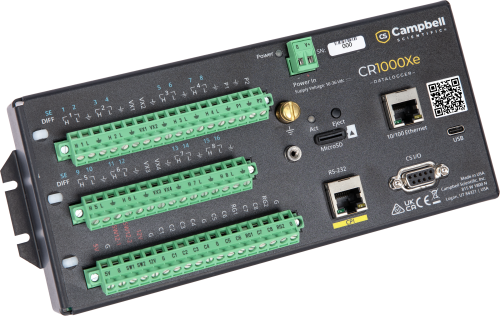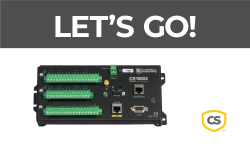
Enhanced with additional serial I/O, power control, and MQTTS to Meteorological Data Management Systems like CampbellCloud™






Overview
The CR1000Xe provides measurement and control for a wide variety of applications. Its reliability and ruggedness make it an excellent choice for remote environmental applications including stations for hydrology and meteorology (HydroMet), solar resource assessment and monitoring (SRA/SRM), dams and mines (geotech), and broad research objectives for environmental systems.
The CR1000Xe is a low-powered device that measures analog and digital sensors, processes and stores measurements, and adapts to any communications link. It stores data and programs in non-volatile flash memory. The onboard programming language—common to all Campbell Scientific data loggers—allows users to create solutions perfectly tailored to the application.
Learn more about our CampbellAero™ Automated Weather Observing System (AWOS) Solution.
Read More
Benefits and Features
- Operates in extreme environments with a standard operating range of -40° to +70°C and an extended operating range of -55° to +85°C
- Connects directly to a computer's USB port
- Captures quickly changing data values with fast analog measurement capabilities (300+ Hz)
- Differentiates even slight changes in data values with higher-resolution measurements (24 bit Adc)
- Includes two non-isolated current input channels for directly connecting sensors with 0-to-20 mA or 4-to-20 mA current outputs
- Contains an onboard CPI port for hosting Campbell Scientific high-speed sensors and distributed modules (such as the GRANITE™ Series)
- Directly connects to Ethernet
- Includes microSD card drive for extended memory requirements
- Provides simple serial sensor integration and measurement with SDI-12, RS-232, RS-422, and/or RS-485
- Supports full PakBus networking
- Includes embedded web page for direct connection via web browser
- Offers a broad input voltage range of 10 to 36 Vdc
- Provides regulated 12 Vdc power output
- Controls CS I/O power to external modems
Images





3D/CAD Files:
Detailed Description
The CR1000Xe electronics are shielded from radio frequency by a unique, sealed, stainless-steel canister. It includes a low-drift, battery-backed clock that can be updated by NTP, GPS, and Campbell Scientific's PakBus®. The canister and wiring panel seal together through stainless-steel connectors. The CPI and Ethernet pins are gold coated to resist corrosion. The CR1000Xe is compatible with 12 V- and 24 V-nominal systems. The data logger's wiring panel regulates 12 V outputs and includes two switchable 12 V outputs on removable terminal blocks and a switchable 12 V output on CS I/O.
Compatibility
Please note: The following shows notable compatibility information. It is not a comprehensive list of all compatible products.
Communication Devices
| Product | Compatible | Note |
|---|---|---|
| CR1000KD |
Miscellaneous
| Product | Compatible | Note |
|---|---|---|
| 05305-L | ||
| AVW200 | ||
| CE4 | ||
| COM220 | ||
| CS547A-L | ||
| CS616 | ||
| FW05 | The CR1000Xe is compatible when used with the CDM-A108 or CDM-A116. | |
| FW1 | The CR1000Xe is compatible when used with the CDM-A108 or CDM-A116. | |
| FW3 | The CR1000Xe is compatible when used with the CDM-A108 or CDM-A116. | |
| LLAC4 | ||
| LoggerLink | ||
| RTDAQ | ||
| SDM-CD16D (retired) | ||
| SDM-CD16S | ||
| SDM-CVO4 (retired) | ||
| SDM-IO16 (retired) | ||
| SDM-SIO2R |
Additional Compatibility Information
Sensors
With several terminal types, the CR1000Xe is compatible with nearly every available sensor, including analog (both voltage and current), serial, thermocouples, SDI-12, pulse, and frequency sensors.
Measurement and Control Peripherals
The CR1000Xe is compatible with all our multiplexers, vibrating wire interfaces, terminal input modules, and relays.
Communications
The CR1000Xe communicates via USB; 10/100 Ethernet; and multiple serial interfaces that support cellular, Wi-Fi, satellite (such as GOES, Meteosat, Iridium, and Inmarsat), and many other wired and wireless communications links.
Data can be viewed locally using Campbell Scientific software for Windows, iOS, and Android. Additionally, multiple keyboard display options are available with the CR1000KD, CD100, and CD295.
Enclosures
The CR1000Xe and its power supply can be housed in any of our standard enclosures.
Power
Any 12- or 24-Vdc source can power the CR1000Xe datalogger. Campbell Scientific power supplies commonly used with the CR1000Xe are the PS150 and PS200.
Software
Campbell Scientific software is available to program, configure, and communicate with the CR1000Xe datalogger. Various software options are available including PC400, LoggerNet, and CampbellCloud. Consult with our sales engineers to determine the best software or cloud option.
Specifications
| Operating Temperature Range |
|
| Maximum Scan Rate | 1000 Hz |
| Case Material | Anodized aluminum |
| Analog Inputs | 16 single-ended or 8 differential (individually configured). Two analog inputs can measure 4 to 20 mA or 0 to 20 mA natively. Four analog inputs can provide pulse/digital I/O functions. |
| Pulse Counters | 10 (P1 to P2 and C1 to C8) |
| Voltage Excitation Terminals | 4 (VX1 to VX4) |
| Maximum Source/Sink Current |
|
| Communications Ports |
|
| Data Storage Slots | microSD |
| Switched 12 Volt | 2 terminals, plus CS I/O pin 8 |
| Digital I/O | 8 terminals (C1 to C8) configurable for digital input and output. Includes status high/low, pulse width modulation, external interrupt, edge timing, switch closure pulse counting, high-frequency pulse counting, plus UART, RS-232, RS-485, SDM, SDI-12, I2C, and SPI serial-communications functions. Terminals are configurable in pairs for 5 V or 3.3 V logic for some functions. |
| Input Limits | ±5 V |
| Analog Voltage Accuracy |
|
| ADC | 24-bit |
| Power Requirements | 10 to 36 Vdc input |
| Real-Time Clock Accuracy | ±3 min. per year (optional GPS correction to ±10 µs) |
| Internet Protocols | Ethernet, PPP, RNDIS, ICMP/Ping, Auto-IP (APIPA), IPv4, IPv6, UDP, TCP, TLS (v1.2), DNS, DHCP, SLAAC, Telnet, HTTP(S), SFTP, FTP(S), POP3/TLS, NTP, SMTP/TLS, SNMPv3, CS I/O IP, MQTT(S) |
| Communication Protocols | CPI, PakBus, SDM, SDI-12, Modbus, TCP, DNP3, UDP, NTCIP, NMEA 0183, I2C, SPI, CampbellCloud HTTPS/MQTTS, and others |
| Battery-backed SRAM for CPU Usage & Final Storage | 4 MB |
| Data Storage | 4 MB SRAM + 72 MB flash (storage expansion of up to 16 GB with removable microSD flash memory card) |
| Idle Current Drain, Average | < 1.5 mA (@ 12 Vdc) |
| Active Current Drain, Average | 1.1 mA (1 Hz scan @ 24 Vdc) |
| Active Current Drain, Average |
|
| Dimensions |
23.8 x 10.1 x 6.2 cm (9.4 x 4.0 x 2.4 in.) Additional clearance required for cables and wires |
| Weight | 0.86 kg (1.9 lb) |
Documents
Manuals
Videos & Tutorials
Downloads
CR1000X Web Browser Interface v.1.2 (970 KB) 13-09-2024
Standard Datalogger Web Browser Interface
Use this download to update the data logger's web browser interface.
To install this file, send it to the data logger using file control found in the Device Configuration Utility or file control found in LoggerNet.
This interface is recommended for fast IP interfaces like Ethernet and Wi-Fi. It does NOT perform well over slow communications mediums like cellular.
Note: This is NOT for system data loggers that have custom interfaces like the SunSentry, Hydro-Link, Alert205, and MeteoPV.
Frequently Asked Questions
Number of FAQs related to CR1000Xe: 4
Expand AllCollapse All
-
Yes. Sign into CampbellCloud through your web browser or CampbellGo™ app, and follow the instructions to add an asset using the data logger’s UID.
-
The following are some highlights of the CR1000Xe to be aware of:
- USB-C
-
12 V in = 10 to 36 Vdc power in
-
12 V out = 2 A
-
SW12 = 2 A
-
SW12 added to CS I/O 12 V pin
-
C1–C4 communications capabilities that match those of C5–C8
-
Enhanced protection on the Ethernet port
When the CR1000Xe is used with your existing system, it will operate the same and look the same as a CR1000X.When the CR1000Xe is used with a new system, you may be able to lower your system cost.
-
The following are some highlights of the CR1000Xe to be aware of:
- USB-C
-
12 V in = 10 to 36 Vdc power in
-
12 V out = 2 A
-
SW12 = 2 A
-
SW12 added to CS I/O 12 V pin
-
C1–C4 communications capabilities that match those of C5–C8
-
Enhanced protection on the Ethernet port
When the CR1000Xe is used with your existing system, it will operate the same and look the same as a CR1000X.When the CR1000Xe is used with a new system, you may be able to lower your system cost.
-
The following are some highlights of the CR1000Xe to be aware of:
- USB-C
-
12 V in = 10 to 36 Vdc power in
-
12 V out = 2 A
-
SW12 = 2 A
-
SW12 added to CS I/O 12 V pin
-
C1–C4 = C5–C8
-
Enhanced protection on the Ethernet port
-
Stainless-steel "D" connectors between the wiring panel and the CPU rather than nickel-plated connectors
When the CR1000Xe is used with your existing system, it will operate the same and look the same as a CR1000X.
When the CR1000Xe is used with a new system, you may be able to lower your system cost.
Privacy Policy Update
We've updated our privacy policy. Learn More









